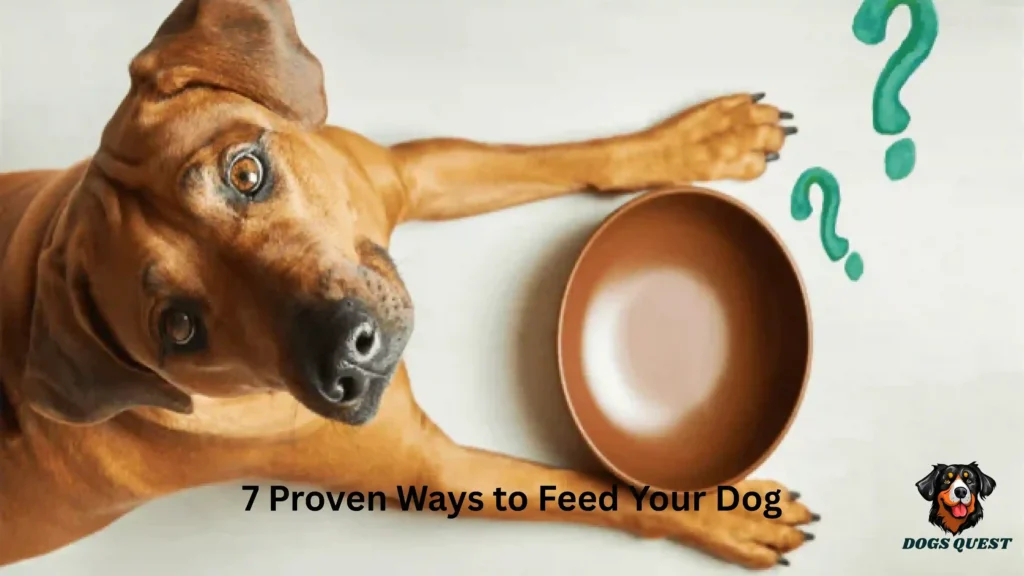7 Proven Ways to Feed Your Dog the Right Amount Discover portion sizes, feeding charts, and diet advice for puppies, adults, and senior dogs. How much should I feed my dog? Discover the right portion sizes for every age, weight, and breed. Follow our expert feeding guide to keep your dog healthy, happy, and active.
How Much Should I Feed My Dog
If you’re a dog parent, you’ve probably asked yourself at least once: “Am I feeding my dog the right amount?” It’s one of the most common questions vets hear, and for good reason. Feeding too little can lead to malnutrition, while feeding too much can cause obesity and health problems.
The truth is, there’s no one-size-fits-all answer. The amount of food your dog needs depends on factors like age, breed, activity level, and overall health. In this guide, we’ll walk through 7 key tips that will help you figure out exactly how much you should feed your dog.
Let’s dive in! 🐾
Why Feeding the Right Amount Matters

Dogs thrive when they get the right balance of nutrients in proper portions. Feeding too much or too little can lead to serious health issues.
- Overfeeding risks: Obesity, diabetes, joint issues, heart disease.
- Underfeeding risks: Nutritional deficiencies, weakness, poor coat health, stunted growth (in puppies).
- Balanced feeding benefits: Healthy weight, strong immunity, shiny coat, and a happy, energetic pup.
7 Key Tips to Determine How Much to Feed Your Dog
1. Follow the Feeding Guidelines on Dog Food Labels
Most commercial dog foods come with feeding instructions printed on the bag or can. These recommendations are based on your dog’s weight and age.
However, treat them as a starting point. Every dog is unique — some may need a little more, others a little less. Adjust based on your dog’s body condition and energy level.
Pro Tip: Always measure food with a cup or scale instead of eyeballing portions.
2. Consider Your Dog’s Age
- Puppies: Growing pups need more calories, protein, and fat. They typically eat 3–4 small meals daily.
- Adult dogs: Most adult dogs thrive on 2 meals per day.
- Senior dogs: Older dogs may require fewer calories but more nutrient-rich foods to support joint and organ health.
Feeding by life stage ensures your dog gets the right nutrition for growth, maintenance, or healthy aging.
3. Factor in Breed and Size
Different breeds have different metabolic rates:
- Toy & small breeds (under 20 lbs): Higher metabolism; need more calories per pound. Example: Chihuahuas, Yorkies.
- Medium breeds (20–50 lbs): Average calorie needs. Example: Beagles, Cocker Spaniels.
- Large breeds (50–90 lbs): Need steady nutrition to support joints and prevent obesity. Example: Labradors, Golden Retrievers.
- Giant breeds (90+ lbs): Require carefully balanced diets to prevent bone and joint problems. Example: Great Danes, Mastiffs.
Breed-specific feeding guidelines are crucial for long-term health.
4. Match Food Portions to Activity Leve
Just like humans, active dogs burn more calories.
- High-energy dogs: Working dogs, herding breeds, or very active pets need more food.
- Average dogs: Family pets with daily walks need moderate portions.
- Low-activity dogs: Senior or sedentary dogs may need fewer calories.
Example: A Border Collie who runs daily may eat double the calories of a couch-loving Bulldog.
5. Monitor Body Condition Score (BCS
Instead of just relying on weight, check your dog’s Body Condition Score (BCS).
- Healthy dog: You should feel ribs easily but not see them. Waistline visible from above.
- Overweight dog: Hard to feel ribs; round belly; no waistline.
- Underweight dog: Visible ribs, hips, and spine.
Adjust food portions weekly based on BCS rather than numbers on a scale alone.
6. Don’t Forget Treats and Snacks
Treats are great for training and bonding, but they shouldn’t make up more than 10% of daily calories.
Example: If your dog needs 800 calories daily, treats should be no more than 80 calories.
👉 Over-treating is one of the top causes of dog obesity. Use healthy snacks like baby carrots, apple slices (without seeds), or small training treats.
7. Ask Your Vet for Personalized Advice
Every dog is unique. Factors like health conditions (diabetes, kidney disease, allergies) may require special diets.
Your vet can help:
- Recommend calorie counts.
- Suggest therapeutic diets if needed.
- Monitor weight and adjust feeding plans.
For new puppies, senior dogs, or dogs with health problems, a vet’s guidance is priceless.
Sample Feeding Chart for Dog
Here’s a rough guide for average, healthy adult dogs eating commercial kibble:
| Dog Weight | Daily Food (Cups) | Calories per Day |
|---|---|---|
| 10 lbs | ¾ – 1 cup | 200–275 |
| 20 lbs | 1 – 1 ½ cups | 325–400 |
| 40 lbs | 2 – 2 ½ cups | 600–800 |
| 60 lbs | 3 – 3 ½ cups | 900–1100 |
| 80 lbs | 3 ½ – 4 ½ cups | 1100–1350 |
| 100 lbs | 4 ½ – 5 cups | 1350–1500 |
Note: These are general estimates. Food brands vary in calorie density, so always check the packaging.
Special Considerations When Feeding Your Dog

Puppies
- Eat 3–4 times a day.
- Need puppy-formulated food for growth.
Senior Dogs
- Lower calorie needs.
- Look for food with joint-supporting nutrients like glucosamine.
Dogs with Health Issues
- Diabetic dogs need controlled carb intake.
- Allergic dogs may need hypoallergenic or limited-ingredient diets.
- Dogs with kidney issues require special low-protein food.
Final Thoughts
So, how much should you feed your dog? The answer depends on your dog’s size, age, breed, activity level, and health. Start with food label guidelines, monitor your dog’s body condition, and adjust as needed.
Remember:
- Puppies need frequent, calorie-rich meals.
- Adult dogs thrive on 2 balanced meals a day.
- Seniors need fewer calories but more targeted nutrition.
- Always include exercise and limit treats.
When in doubt, consult your vet for tailored feeding advice. A healthy diet equals a happy, tail-wagging companion
FAQs :
1. How many times a day should I feed my dog?
Most adult dogs do well with two meals per day. Puppies need 3–4 meals, while seniors may benefit from smaller, more frequent meals.
2. Can I free-feed my dog?
Free-feeding (leaving food out all day) can cause obesity. Scheduled meals are healthier and allow you to monitor intake.
3. How do I know if I’m feeding my dog enough?
Check your dog’s body condition. If ribs are hard to feel, cut back. If ribs are too visible, increase food.
4. Should I feed wet or dry food?
Both are good options. Dry food helps with dental health, while wet food adds hydration. Many owners mix both.
5. Do dogs need snacks between meals?
No, but healthy treats are great for training. Just keep them under 10% of daily calories.

